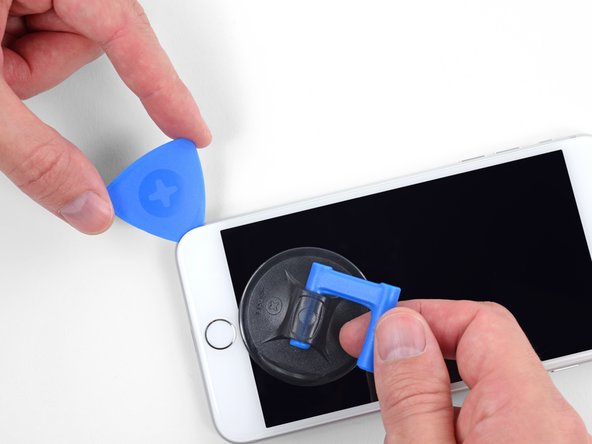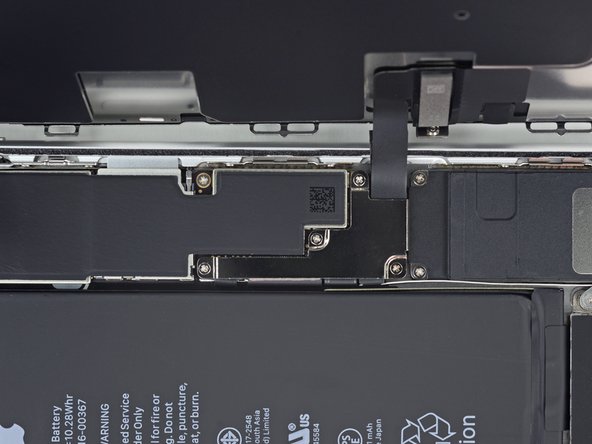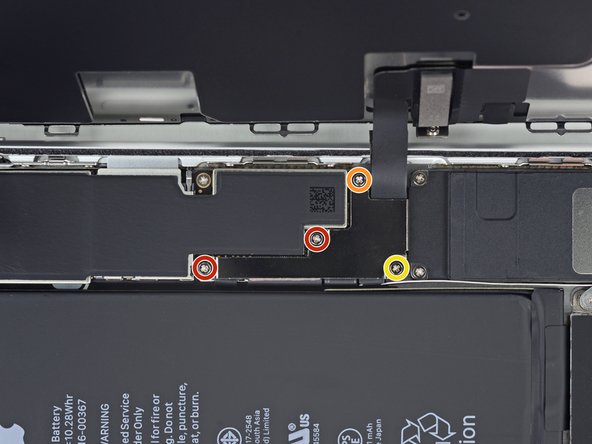iPhone 8 Plus Earpiece Speaker Replacement
Duration: 45 minutes
Steps: 30 Steps
The earpiece speaker on your iPhone 8 Plus isn't just for those private chats; it also cranks up the volume as a loudspeaker, delivering some epic stereo sound! If your earpiece speaker is misbehaving, don't worry—just follow this guide to get it out and replace it like a pro.
Step 1
Before you start, let your iPhone battery dip below 25%. Trust us—nobody wants a surprise firework show from a punctured battery.
Opening up your iPhone's display? Heads up – this will break the waterproof seals. Before you dive in, make sure you’ve got replacement seals on hand, or if you skip that step and reassemble your iPhone without new seals, just be cautious about exposing it to water.
- Make sure your iPhone is totally powered down before you start popping it open.
- Unscrew the two tiny 3.5 mm pentalobe screws hanging out at the bottom edge of your iPhone.
Step 2
Be careful when inserting your opening pick – too far in and you might end up hurting your device. Mark your pick to avoid any mishaps.
You can also make marks at the other corners of the pick for extra precision.
Another trick: tape a coin to the pick, about 3mm from the tip, for a quick and simple measuring guide.
- Measure 3 mm from the tip and mark your opening pick with a permanent marker to keep things on point.
Step 3
Slip on some safety glasses to keep those sneaky shards of glass from making a surprise visit to your eyes during the repair.
Got a cracked screen on your iPhone? No worries! Keep things under control and avoid any potential cuts by sticking some tape over that glass.
If you're really in a bind, a little superglue on the suction cup can help it stick to the screen while you work.
- Cover the iPhone screen with overlapping strips of clear packing tape—think of it as giving your phone a shiny new armor.
- If the suction cup refuses to cooperate in the next steps, fold a sturdy piece of tape (duct tape is a classic go-to), make yourself a makeshift handle, and use that to lift the screen.
Step 4
The next three steps walk you through using the Anti-Clamp, a nifty tool we created to make opening your device a breeze. If you’re not using the Anti-Clamp, just skip ahead three steps for another way to open it.
For full details on how to work the Anti-Clamp like a pro, check out this guide.
If your iPhone’s surface feels too slick for the Anti-Clamp to get a grip, no worries — just slap on some tape to give it a little extra traction.
- Give that blue handle a gentle pull backward to set the Anti-Clamp's arms free.
- Slide those arms over either the left or right edge of your iPhone—whichever feels right.
- Aim the suction cups right above the home button near the bottom edge: one on the front, one on the back.
- Squeeze the cups together to get a solid hold on your device.
Step 5
- Slide the blue handle forward to lock the arms in place.
- Rotate the handle clockwise a full 360 degrees or until you notice the suction cups beginning to stretch.
- Keep an eye on the suction cups to ensure they stay perfectly aligned. If they start to drift, just loosen them a bit and realign the arms before continuing.
Step 6
Keep it chill: only give it a quarter turn each time, then let it hang out for a minute. The Anti-Clamp and a little patience will make it happen.
You can also try a hair dryer, heat gun, or hot plate—but watch out, too much heat might mess with the screen or battery, so take it easy.
If the Anti-Clamp isn't opening enough, heat the spot a bit more and twist the handle about a quarter turn.
- Warm up the iOpener and slip it through the Anti-Clamp's arms like threading a needle.
- Fold the iOpener so it cozies up to the bottom edge of your iPhone.
- Give it a minute—let the adhesive loosen up and create a nice little gap for you.
- Once the Anti-Clamp opens things up, slide an opening pick under the screen and work your magic.
- Go ahead and skip the next three steps. You've got this!
Tools Used
Step 7
The following three steps will guide you on how to gently detach the screen using a handy suction cup.
Warming up the lower edge of your iPhone will help loosen the sticky adhesive holding the display in place, making it a breeze to lift open.
- Grab a hairdryer or an iOpener and gently warm up the lower edge of your iPhone for about 90 seconds. This will help loosen up the adhesive underneath, making the next step a bit easier.
Tools Used
Step 8
Make sure the suction cup stays clear of the home button—if it overlaps, it won’t seal properly against the front glass, and that’s no good!
- Place a suction cup near the bottom half of the front panel, just above the home button, and give it a gentle press. You're almost there!
Step 9
The waterproof glue holding your screen is seriously tough, so getting that first little gap takes some muscle. If it’s not budging, hit it with a bit more heat and gently wiggle the screen up and down—this helps soften the adhesive enough to sneak your tool in.
- Give that suction cup a good tug with steady pressure to open up a little space between the front panel and the rear case. You're doing great!
- Slide in an opening pick or a thin pry tool just a couple of millimeters into that gap you've created. Keep it gentle!
Step 10
- Take your pick and cruise around the corner, then head up the left side of the phone. You're aiming for those volume buttons and the silent switch—keep breaking up that stubborn adhesive holding the display.
- Pause when you reach the top left corner of the screen. Nice work so far!
Step 11
Heads up! There’s a fragile cable running along the right edge of your iPhone. Avoid sliding your pick there to keep things safe and sound.
Step 12
Keep your pick under 3 mm deep—going further could tangle with the display cables, and no one wants that kind of drama.
- Slide your tool back into the lower right corner of the iPhone, and gently glide it around the corner and up the right side of the device to break free the adhesive. You've got this!
Step 13
Keep the display tilt under 15º to avoid stressing or snapping those delicate ribbon cables – they’re tougher than they look, but not that tough!
- Give that suction cup a gentle tug upward to start lifting the bottom edge of the display.
Step 14
- Give a gentle tug on the little tab of the suction cup to pop it off the front panel.
Step 15
- Gently slide an opening pick under the display at the top edge of your phone to break free the last stubborn bits of adhesive. You've got this!
Step 16
- Gently slide the display assembly downwards, away from the top edge of your phone, to pop those clips free from the rear case. You've got this!
Step 17
Hold up—don’t yank the display off just yet! There are some delicate ribbon cables still hanging on for dear life between the screen and the iPhone’s logic board.
- Pop open the iPhone by lifting the display from the left side, like you're opening a book. Nice and easy.
- Propping the display up against something will keep it steady while you work. It's like giving your phone a little support while you do your magic.
Step 18
- Take out the four Phillips (JIS) screws holding down the lower display cable bracket on the logic board. Here's the lineup:
- Keep track of every screw as you go—mixing them up during reassembly can cause serious trouble.
- Two screws measuring 1.3 mm
- One screw measuring 1.4 mm
- One screw measuring 2.7 mm
Step 19
- Time to lift out that lower display cable bracket. Keep it classy, keep it steady.
Step 20
- Grab your trusty spudger and gently pop the battery connector up from its spot on the logic board. Like giving it a little high five to say, 'Hey, take a break!'
- Lift the connector cable just a bit so it stays out of the way—and doesn’t sneak back into the socket and juice up your phone when you’re mid-repair.
Tools Used
Step 21
- Grab a spudger or your trusty fingernail and gently pry the large lower display connector straight up from its socket. Easy peasy!
- When it’s time to reconnect, just press down on one side of the connector until you hear that satisfying click, then do the same on the other side. Remember, no pressing down in the middle! If it’s even a smidge misaligned, you could bend the connector and that would be a total bummer. Keep it straight and snug!
Tools Used
Step 22
- Unplug the second lower display cable connector, which is right behind the one you just removed in the previous step.
Step 23
- Time to remove those two tri-point Y000 screws holding the bracket over the front panel sensor connector:
- One screw that's 1.0 mm
- One screw that's 1.2 mm
Step 24
- Pop off the bracket that's hanging out over the front panel sensor assembly connector.
Step 25
- Gently pop off the front panel sensor assembly connector using either the tip of your spudger or your fingernail. Easy does it—no need to flex those muscles here!
Tools Used
Step 26
- Take off the display assembly carefully.
- When putting it back together, this is a great spot to pause if you want to swap out the adhesive lining the edges of the display.
Step 27
- Let's get those five Phillips screws out of the way to free the earpiece speaker bracket! You've got this:
- Two tiny 1.8 mm screws
- One slightly bigger 2.3 mm screw
- One 2.4 mm screw that's ready to be removed
- And one 2.8 mm screw to finish the job!
Step 28
- Take off the earpiece speaker bracket with care. You've got this!
Step 29
- Grab your trusty spudger and gently nudge the front-facing camera out of its cozy little home.
- With care, give that camera ribbon cable a little bend to the side so you can make way for the earpiece speaker hanging out below.
Tools Used
Step 30
- Double-check your new part against the original one—you might need to move over some leftover components or peel off any sticky backings before you pop the new part in.
- Now, to put everything back together, just follow those steps you did earlier, but in reverse. It’s like a fun puzzle!
- Got some e-waste? Don't just toss it—take it to a certified recycler. It’s good for the planet!
- Things not going as planned? No worries! Head over to our Answers community for some troubleshooting magic. And remember, if you get stuck, you can always schedule a repair.



































































